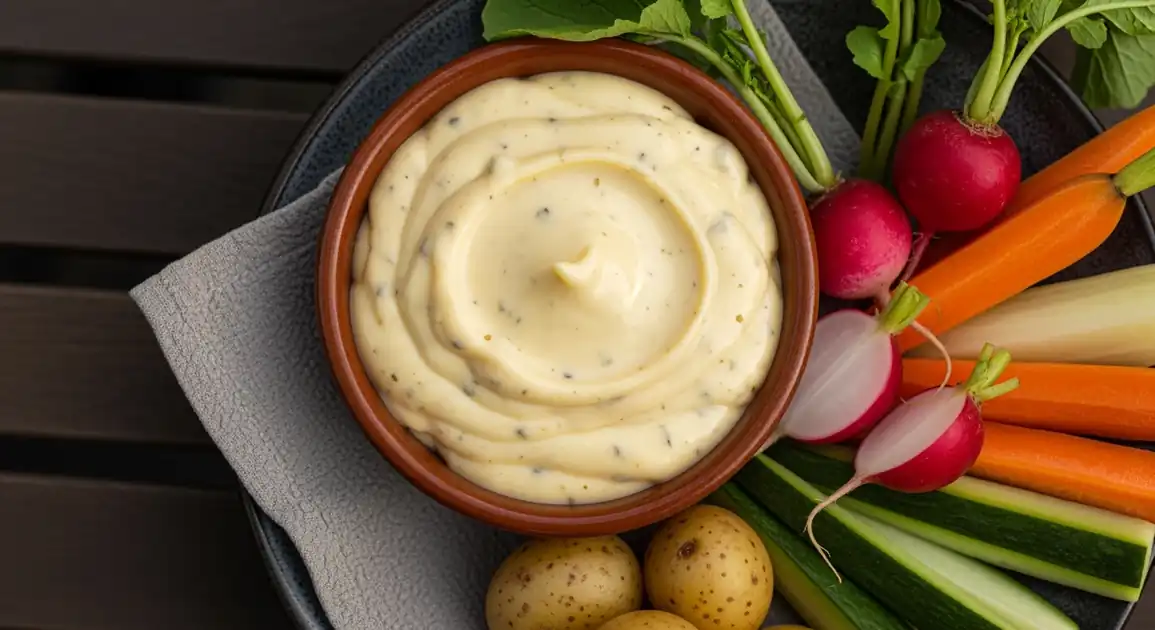Aioli
Aïoli

Description
In Marseille, France's oldest and second-largest city, aioli holds special significance. This Mediterranean port city embraces its Provençal heritage through this iconic garlic sauce, featuring it prominently in the city's cuisine. Along the Vieux Port and in traditional restaurants, aioli accompanies the city's famous seafood and appears in its most authentic form in the Grand Aïoli tradition.
Dietary Information
Serving information
Serving style
In Marseille, aioli is commonly served in small ceramic ramekins alongside seafood dishes or as the centerpiece of Grand Aïoli. Often presented with crusty bread and various accompaniments arranged artistically around the central aioli bowl.
Quick facts
Markets: 7 AM - 1 PM. Restaurants: 12 PM - 2:30 PM for lunch, 7 PM - 10:30 PM for dinner. Many traditional places close on Sundays or Mondays.
Safety Tips
What to Look For
-
Freshly made aioli prepared same-day
Due to raw egg content, freshness is essential. Quality establishments make aioli daily.
-
Proper refrigeration
Aioli should be kept consistently chilled when not being served. Look for aioli served in chilled containers or with ice underneath.
-
Consistent, homogenous texture
Well-made aioli maintains a uniform texture. Separation indicates poor technique or old product.
-
Clean utensils provided for serving
To prevent cross-contamination, ensure fresh utensils are available, especially in communal dining settings.
-
Made with quality oils and fresh eggs
Ask if they use extra virgin olive oil and fresh eggs. Better ingredients make both safer and tastier aioli.
What to avoid
-
Aioli with separated layers or broken appearance
Separation indicates either poor preparation or, more concerning, that the emulsion has broken down over time due to age or improper storage.
-
Yellow or gray discoloration
Discoloration beyond the natural pale yellow suggests oxidation or spoilage.
-
Overly sour or 'off' smell
While aioli should smell of garlic, any sour or unpleasant odors suggest spoilage.
-
Room-temperature aioli that's been sitting out during service
Due to raw egg content, aioli shouldn't remain at room temperature for extended periods. Reputable places will keep it chilled.
-
Pre-packaged aioli with long shelf lives
These often contain preservatives and may not reflect authentic preparation methods. Fresh is always preferable.
Price information
Price range
Budget tips
- Local markets like Marché de Noailles offer small containers of fresh aioli for 3-5 EUR.
- Neighborhood bistros serve aioli with fish for 4-6 EUR as a side.
- For the full Grand Aïoli experience, expect to pay 15-20 EUR, with the best value at lunch.
- Many restaurants offer a formule midi (lunch menu) that includes traditional dishes at better prices.
- The most economical option is aioli from market vendors to enjoy with your own bread and vegetables.
Value indicators
- Made fresh daily.
- Strong but not overwhelming garlic flavor.
- Uses local olive oil from Provence.
- Properly emulsified with a glossy appearance.
- Generous portion size relative to price.
- For Grand Aïoli, variety and quality of accompaniments.
Where to Find This Dish
Vieux Port (Old Port)
The historic harbor area houses numerous traditional Provençal restaurants serving authentic aioli.
Quai des Belges, La Canebière, Restaurants with outdoor seating facing the port
Lunch (12 PM - 2 PM), Early Dinner (7 PM - 9 PM)
Marché de Noailles / Capucins
This vibrant market (known as the 'stomach of Marseille') has vendors selling freshly made aioli.
La Canebière, Near Place Jean-Jaurès
Morning (8 AM - 12 PM), Early Afternoon (12 PM - 2 PM)
Le Panier
The old town district features small traditional restaurants serving regional specialties including aioli.
Near Vieille Charité, Montée des Accoules
Lunch, Dinner
Vallon des Auffes
This tiny fishing port houses traditional fish restaurants where aioli is served with fresh catches.
The small harbor bridge, Chez Fonfon, Chez Jeannot
Lunch, Dinner
Vendor Tips
- In Marseille, ask specifically for aioli 'à l'ancienne' for the most traditional preparation.
- Look for places that make their aioli in-house ('fait maison'), especially important in touristy areas.
- Fridays are still the traditional Grand Aïoli day in more authentic establishments.
- Some fishmongers at the daily fish market at Vieux Port sell aioli to accompany their fresh seafood.
How to Order
Regional Variations
-
Aioli with Seafood
(Aïoli aux Fruits de Mer)
In this port city, aioli is frequently served with various types of seafood beyond the traditional salt cod, including fresh fish, mussels, and sometimes even sea urchin.
-
Rouille
(Rouille Marseillaise)
While technically a variation of aioli, this saffron and pepper-infused sauce is essential to Marseille's famous bouillabaisse and represents a local adaptation.
-
Rustic Aioli
(Aïoli Rustique)
Some traditional establishments in Marseille's older neighborhoods still prepare aioli the ancient way, using only garlic and oil (no egg), pounded extensively in a mortar until emulsified. This labor-intensive version is increasingly rare.
-
Olive-Infused Aioli
(Aïoli aux Olives)
A Marseille specialty incorporating local black olives (often Nyons or Kalamata) either chopped into the aioli or as a paste, creating a more intense Mediterranean flavor.
Cultural context
History
Aioli's roots trace back centuries in Mediterranean culture, with historical records showing garlic-oil preparations in Roman times. The modern version from Provence evolved alongside similar garlic sauces from Spain (allioli) and Italy (agliata). Traditionally prepared in a mortar and pestle, aioli became a Friday staple in Provençal households, particularly in fishing communities where it accompanied salt cod. The dish symbolized both frugality and celebration, bringing families together for a simple yet satisfying meal that showcased local produce and the region's abundant garlic.
Local significance
In Marseille, aioli represents the city's Provençal heritage and Mediterranean culinary identity. It's considered a taste of authentic local cuisine and often associated with convivial, shared meals.
Eating customs
- In Marseille restaurants, it's common to spread a thin layer of aioli on bread before adding fish or vegetables.
- When enjoying bouillabaisse, a small dollop of rouille (aioli's close cousin) is often added to the broth.
- Local diners appreciate when the garlic flavor is present but not overwhelming – balance is key.